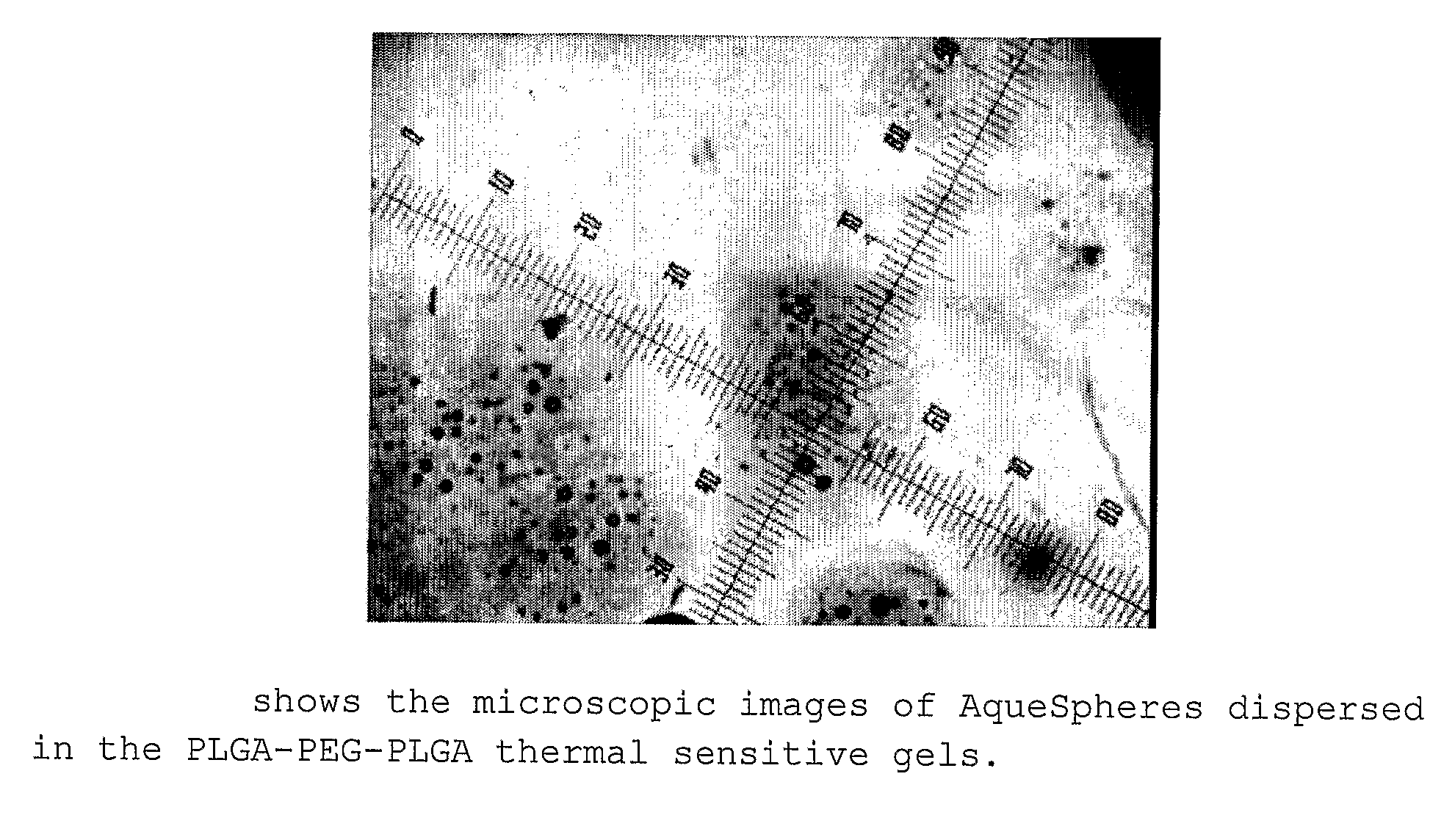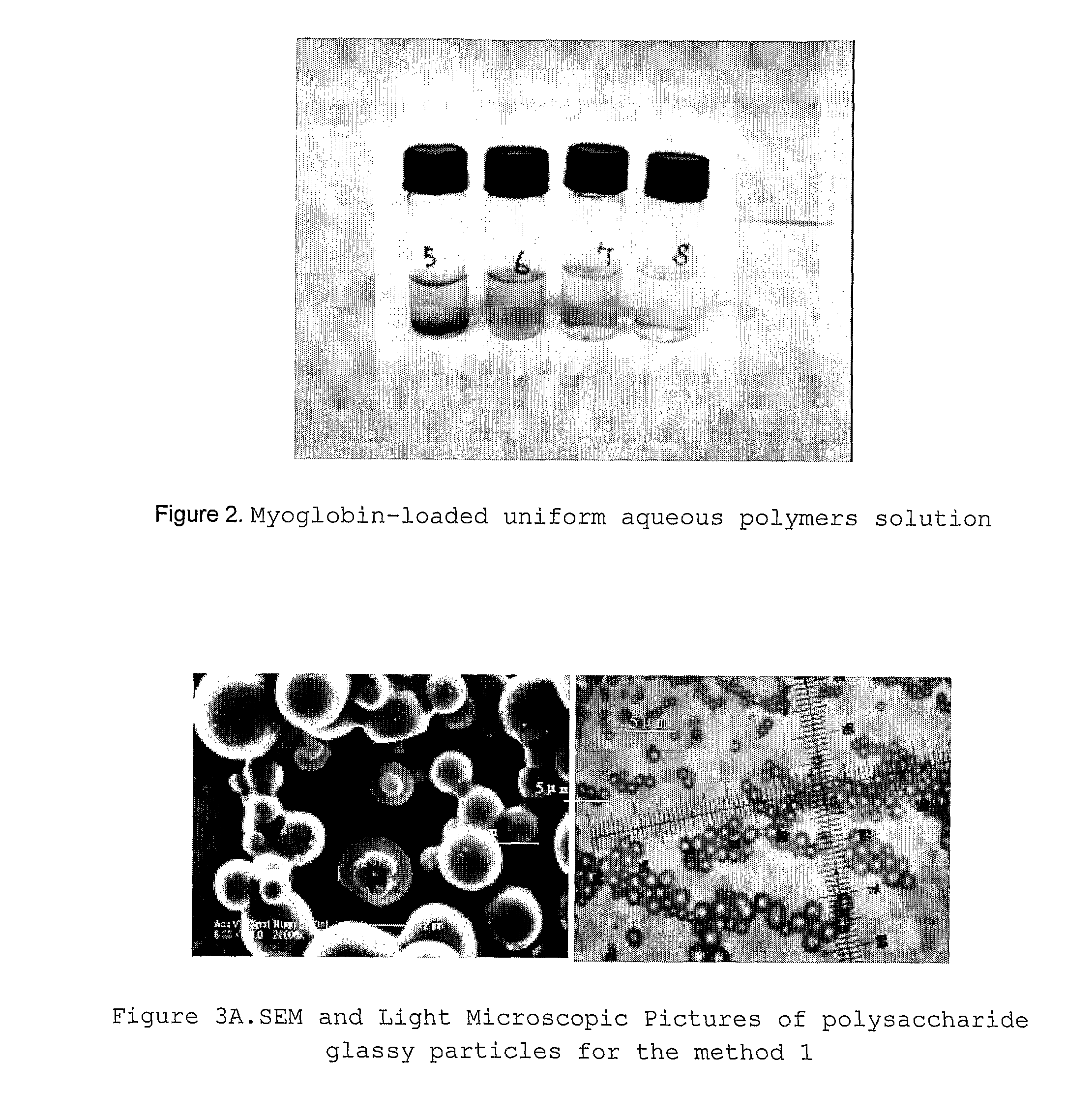Polysaccharide Microparticles Containing Biological Agents: Their Preparation and Applications
a technology of polysaccharide microparticles and biological agents, applied in the field of polysaccharide microparticles containing biological agents : their preparation and application, can solve the problems of low loading capacity of proteins, compromised system, and inability to load proteins into fine polysaccharide particles, and achieve the effect of facilitating uptak
- Summary
- Abstract
- Description
- Claims
- Application Information
AI Technical Summary
Benefits of technology
Problems solved by technology
Method used
Image
Examples
example 1
Preparation of Polysaccharide Glassy Particles (AqueSpheres) Using Low Temperature Aqueous-Aqueous Emulsification
[0080]A fairly stable aqueous-aqueous emulsion was prepared by simply mixing a 10 w / w % dextran solution (containing 2 w / w % myoglobin) with a 10 w / w % PEG solution at 0-4° C. A small molecular sugar, trehalose (1 w / w %) was added in the dextran solution as protein stabilizer for lyophilization. FIG. 1 shows photo and microscopic images of the aqueous-aqueous stored in a refrigerator for 1 hour. The sample was removed from the refrigerator and images were quickly taken before the dispersed phase fuses at elevated temperature.
[0081]The size of the dispersed dextran phase (the droplets) ranged between 3-7 μm in diameter, similar to those prepared using polyelectrolyte stabilizers at room temperature [5,8]. This emulsion sample was then frozen at −20° C, followed by lyophilization and dichloromethane-washing to remove the continuous PEG phase. Photo and microscopic images of...
example 2
Preparation of Polysaccharide Glassy Particles (AqueSpheres) Using Freezing-Induced Phase Separation
[0082]For a solution system containing dextran and PEG, its phase separation is a function of temperature, and concentration and molecular weight of the hydrophilic polymers [11]. In order to prepare a solution which is single phase at room temperature but becomes two phases (dispersed and continuous phases), a series of solutions containing dextran, PEG and myoglobin but different in concentrations were prepared at room temperature. A small molecular sugar, trehalose (1 w / w %) was added in the dextran solution as protein stabilizer for lyophilization. FIG. 2 shows photographs of the mixed solutions of various concentrations of dextran, PEG and myoglobin (See the figure legend for FIG. 1). Among these samples, that formed by mixing two solutions each containing 10 w / w % dextran and 10 w / w % PEG separated to two phases. All the other samples with lower concentration of dextran and PEG...
example 3
Encapsulation of AqueSpheres into PLGA Microspheres
[0084]Protein containing fine polysaccharide glassy particles (AqueSpheres) may easily encapsulated in PLGA microspheres using a solid-in-oil-in-water (S-O-W) method used in our previous invention [8]. In brief, AqueSphares were suspended in a dichloromethane solution of PLGA, then the suspension was added into a containing polyvinyl alcohol 0.5-1.5 w / w %) and NaCl (5-10 w / w %) at 1 / 6 valume ratio under stirring. Once a composite double emulsion was formed, this S-O-W system was immediately added large cold water (˜0-10 ° C.) under gentle stirring for preliminary hardening, followed by aging and rinsing (to remove polyvinyl alcohol and NaCl). The PLGA microspheres obtained were lyophilized again to remove water and solvent residues prior to storage.
[0085]FIG. 5A shows the optical microscopic images of the PLGA droplets before (left) and after (right) preliminary hardening. FIG. 5B and 5C show electroscopic images of the hardened PLG...
PUM
| Property | Measurement | Unit |
|---|---|---|
| diameter | aaaaa | aaaaa |
| diameter | aaaaa | aaaaa |
| particle size | aaaaa | aaaaa |
Abstract
Description
Claims
Application Information
 Login to View More
Login to View More - R&D
- Intellectual Property
- Life Sciences
- Materials
- Tech Scout
- Unparalleled Data Quality
- Higher Quality Content
- 60% Fewer Hallucinations
Browse by: Latest US Patents, China's latest patents, Technical Efficacy Thesaurus, Application Domain, Technology Topic, Popular Technical Reports.
© 2025 PatSnap. All rights reserved.Legal|Privacy policy|Modern Slavery Act Transparency Statement|Sitemap|About US| Contact US: help@patsnap.com



